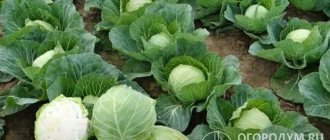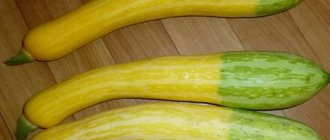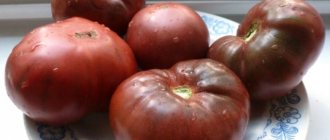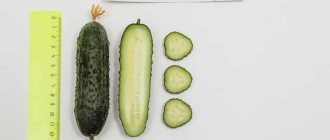One of the most popular varieties of zucchini, cultivated in many Russian regions, is Yakor zucchini. The vegetable is grown in open ground and ripens very quickly, approximately 40 days after the appearance of cotyledon foliage. The plant does not branch much and looks very compact. Breeders and gardeners recognize zucchini as one of the most versatile and easy-to-care plants. It is unpretentious, does not require special growing conditions and has a high yield. Almost no Russian garden can do without this tasty vegetable that can be used in many dishes. In this publication we will learn how to grow Anchor zucchini, consider the description and characteristics of the variety.
Description of the zucchini variety Anchor
Anchor is an early-ripening varietal zucchini for growing in protected and open ground. The vegetable is cultivated almost throughout the entire territory of the Russian Federation, except for the Far North. In accordance with the description of the variety and reviews from gardeners, the fruits have a white-green peel (the glossy skin is clearly visible in the photo), cylindrical shape and excellent taste. The average weight of one fruit is 700-900 g.
Characteristics of the Anchor zucchini:
Characteristics Description
| Variety or hybrid | Variety |
| Features during the growing season | Tolerates short-term cold snaps and droughts |
| Dates of fruiting | 40-45 days after germination |
| Cultivation area | In unprotected soil throughout almost the entire country, except for remote areas of the North |
| Keeping quality | If stored properly, fruits can be stored at biological ripeness for 60-70 days. |
| Disease resistance | Severely affected by white and gray rot of fruits, as well as powdery mildew |
| Bush | Compact, leafy |
| Productivity | 7–12 kg per square meter |
| Transportation | Transports well |
| Usage | For fresh use and processing |
| Peel color | In technical ripeness - white-green, in biological ripeness - yellow |
| Fruit surface | Smooth and thin |
| Pulp | The pulp has a dense structure, juicy, and has a beige tint. |
Anchor's resistance to short-term temperature fluctuations in the middle and end of May, as well as in September, makes it easier for the gardener to care for zucchini and prolongs the growing season and fruiting. In the first ten days of May in many Russian regions, seedlings can be planted in covering tunnels or greenhouses, and at the end of May - in unprotected soil.
The drought resistance of the Anchor is also suitable for many summer residents who come to their plots only for the weekend. If the ground under the bushes is mulched, then 1 abundant watering per week will be enough for good fruiting.
Characteristics and description of the zucchini variety Anchor
One of the most unpretentious vegetables - zucchini - has long and firmly won the love of Russian gardeners. Ease of cultivation and significant yields throughout the season have won the hearts of all lovers of home vegetable growing.
Descriptions of many varieties, zoned in all regions of the country, can be found on the website of the State Plant Register of the Russian Federation. One of the most common and productive is the zucchini variety of the Soviet selection Yakor.
Description of the variety
The characteristics of the variety can be read on the website of the State Plant Register of the Russian Federation, in which it has been included since 1987. An early ripening variety, fruit ripening occurs 41–49 days from germination. The bush form of the plant with weak foliage does not require thinning of leaves during the formation of ovaries.
The light green, cylindrical fruits have an average weight of 0.9 kg, juicy light yellow flesh and good taste. At the stage of technical ripeness, they acquire a light yellow color. The variety is very productive - 7.5–9.7 kg/sq. m. Suitable for commercial production.
The thin bark does not imply long-term storage, however, the fruits store well for a month after picking. Young fruits can be eaten with the peel. Recommended for table purposes.
The variety is zoned in six of the twelve regions of the country, including the Central Black Earth region. It is also cultivated in Ukraine and Moldova, as it is drought-resistant.
Zucchini is intended for growing in open ground due to its cold resistance.
The disadvantages of the variety are low resistance to fungal diseases:
- powdery mildew;
- gray rot;
- white rot.
A description of the variety would be incomplete without pointing out the rapid ripening of its fruits and their delicate taste, which is perfectly preserved during storage and processing.
Harvest storage
Zucchini, which can already be eaten, reaches 14-30 cm in length and weighs no more than 1 kg. Young fruits are perfect for a wide variety of dishes.
Interesting! Experts from Russia prefer to select zucchini suitable for long-term storage in winter, in contrast to their foreign colleagues, who focus only on the young harvest.
The biological maturity of zucchini is very important if it is not planned to be eaten in a short time. During this period, the peel of the vegetable becomes tougher, its length reaches 40-50 cm, and its weight reaches 2.5 kg. If you follow the storage conditions and keep the Anchor zucchini in a cool, dark place, the vegetable will last for at least 30 days. The harvest period is quite long, starting in July and ending in September.
Zucchini harvest
High resistance to cold is one of the main features that distinguishes Yakor squash from other Russian and foreign varieties. It is this advantage that persuades an increasing number of gardeners to choose this particular variety. Even if the summer months are cold, the variety will give a good harvest, it is also not afraid of heat, the zucchini is resistant to drought.
Zucchini Anchor is famous for its ability to adapt to changeable weather conditions, is undemanding in care and does not need a greenhouse. The choice of this variety is guaranteed to provide a high yield.
0 0 votes
Article rating
Characteristics of the variety
The Anchor variety is white-fruited and early ripening: zucchini ripens 30-40 days after the first shoots. Their weight is 0.9 kg and length is 7-15 cm.
With proper care, you can get a harvest of 7 to 9 kg per month.
Due to its tolerance to low temperatures, the vegetable can be grown in open ground.
According to the description, the bush itself is of medium height, small-leaved. The fruits are green, but when the zucchini finally ripens, it takes on a yellow tint.
Features of agricultural technology
Zucchini varieties Yakor are sown for seedlings in the first half of April (depending on the climatic characteristics of the region). Planting of mature plants is carried out 20–30 days after germination, in the 4-leaf phase, until the seedlings have outgrown.
Double selection of zucchini seeds of the Yakor variety is aimed at rejecting initially small, then half-empty seeds that float in the saline solution; they will not produce viable plants. The fruits of the Anchor variety of zucchini are rich in seeds, so there is plenty to choose from.
Advantages and disadvantages of the variety
The advantages of the variety include:
- resistance of root crops to short-term drops in air temperature in late spring and early autumn. This greatly simplifies plant care, extending the growing season and fruiting of the bush. In central Russia, seedlings are planted under film covers from the first days of May.
- drought resistance, which is especially convenient for those summer residents who can only come to their site on weekends. In addition, zucchini is unpretentious to growing conditions, but if there is a lack of attention when caring for the plant, the fruits can not only take a long time to ripen, but also become deformed and become worse in taste.
Reviews from gardeners about this variety
Description of the zucchini variety Anchor includes the following advantages:
- resistance to low temperatures;
- resistance to dry climates;
- does not require much attention;
- rarely gets sick.
- fruit deformation;
- short shelf life.
- Author: Maria Sukhorukikh
Rate this article:
- 5
- 4
- 3
- 2
- 1
(0 votes, average: 0 out of 5)
Share with your friends!
How to grow Anchor squash?
Zucchini variety Anchor has been on the market for more than 50 years. This is the most commonly grown crop in gardens. The variety is early and has good yield. Anchor is a cold-resistant plant, so it is recommended to grow it in open ground. It does not tolerate frost, but at a temperature of 5 C the plant does not die, but only slows down its development. The optimal temperature for growing is 15-18 C.
It is recommended to cover the bush and berries with dry grass from the heat. What are the features of Anchor zucchini? What difficulties may gardeners encounter?
What kind of soil do zucchini like?
The best option for growing zucchini is loamy soil with neutral acidity. Light sandy loam soil and black soil are suitable. In heavy clay soil, plants lag behind in development and often get sick. The vegetable is demanding on soil fertility; the yield declared by breeders is only possible with complete fertilizer. Peaty lands will be an unlucky place due to high humidity. Areas where groundwater comes close to the surface should be avoided. In such places, zucchini are often affected by powdery mildew and other fungal diseases.
To determine the degree of acidity in an area, you will need litmus paper. The earth dissolves in water, and an indicator strip is lowered into it. Red coloring indicates high acidity (pH 3.5-4.5), a light green tint indicates neutrality of the earth. By looking closely at the plants, you can learn about the pH level. Plantain and horsetail grow in acidic soils, clover and chamomile prefer neutral ones.
If you have unsuitable soil on your plot, this is not a reason to refuse to grow tasty and healthy vegetables. It must be changed, supplemented with all the missing components. Not the entire area will have to be improved, but only the areas where the zucchini will be planted. Vegetables are usually grown at the rate of 1-2 bushes per square meter, therefore the volume of necessary substances is offered for the same area.
Clay soil is poor in nutrients and retains moisture for a long time. Sawdust is added to it for looseness, sand for free outflow of moisture and nutritious humus (3:10:3 kg). On sandy loam soil, water does not stagnate, but the fruits are small and weak, they lack organic matter. The addition of compost, sawdust and clay (3:3:10 kg) will change the situation. It is recommended to add humus and turf soil, which has low moisture capacity (2:10 kg), to a wet peat bog. Turf soil is taken under deciduous trees; its properties are close to compost.
You can change the acidity of the soil using liming. The procedure is performed in the fall, the following substances are added:
- slaked lime;
- wood ash;
- dolomite flour.
After adding lime material, the soil is dug up. A large amount of organic matter must be added to the soil for zucchini in open ground. Some gardeners prefer compost, others prefer rotted manure.
Features of growing by seedling method
In order for the harvest to be of high quality, healthy and tasty, you need to grow Anchor zucchini in a well-lit place.
Don't forget about regular watering and fertilizing. It is important to spray your vegetables with pest control products to protect them as much as possible. To prevent the fruits from becoming overripe and spoiled, they must be collected on time.
There are several methods for growing the variety. The most popular is seedling.
Forcing zucchini seedlings of the Anchor variety
The best option for planting treated seeds is neutral combined soil. An acid reaction caused by peat soil can harm the plant. Ideal conditions for seedlings of Anchor zucchini can be created using soil with a peat and compost base. The use of deoxidized chalk and lime is also encouraged.
Zucchini seedlings
When the cotyledonous foliage appears, a picking period begins. After transplanting the seedlings, it is recommended to feed them with a small amount of nitrogen fertilizers; this will have a beneficial effect on the growth of zucchini. After this, a period of preparatory hardening of the plants begins - you need to open the windows in the greenhouse every day or take the boxes out into the open air, increasing the time.
How to grow seedlings from seeds
The seeds are collected when the crop is finally ripe. They are dried all winter and then soaked in a special solution of water and salt: those that have swollen are good and of high quality, they can be planted.
Before planting, the soil is fertilized with chalk or slaked lime. Water the hole and plant a seed in it.
To grow high-quality seedlings you need to know simple requirements:
- when the first shoots appear, the temperature should not be lower than 18°;
- do not forget to water the seedlings;
- transplantation into open ground occurs after the first leaves appear;
- The harvest is harvested in the fall.
Planting in open ground
The zucchini variety Anchor loves sunlight and does not tolerate wind or drafts.
Planted in open ground at the end of spring, when the temperature becomes stable. If at night it drops to 11 ° C, then the plant is covered with a thin layer of film.
Prepare the soil in advance before planting zucchini. To do this, dig a hole in March and fill it with compost. The beds are placed at a distance of a meter so that the vegetables do not interfere with each other.
Zucchini is not a picky crop.
How to plant correctly:
- Place 2-4 zucchini sprouts into the hole.
- Fill the hole with soil and compact it well.
- Water the seedling.
Zucchini care
A sign that it is time to prune weak shoots will be the appearance of the first leaves. Thanks to this process, productivity increases.
Zucchini varieties of the Yakor variety begin to bear fruit when the temperature reaches 11-30 °C. In order for the fruits to be tasty and of high quality, they need to be watered regularly.
Important! As soon as the bush begins to bloom, it needs to be moistened every day. Drought can develop various diseases, such as fungus and rot.
Don't forget to dig up the soil in spring and fall. Occasionally, zucchini needs to be fertilized with nitrogen, manure and urea for prevention.
In order for the fruits to form correctly, they need to be sprayed with a special solution: mix 300 g of crushed (crushed) fish in 10 liters of water.
Technique for planting seedlings in open ground
Anchor zucchini prefer moist soil, for this reason drying out the roots can negatively affect the yield. Before planting, water the plant, mulch the soil of the holes, loosen the dried soil - this retards the evaporation of moisture from the root horizons of the bush’s soil.
A week before planting in open ground, accustom the plant to life outside: in the morning, take the plant out into the fresh air, in the evening return it indoors. Keep an eye on the forecast and plant when it is warm but cloudy outside. This should be done in the evening or early in the morning, but then cover the plants from the sun's rays.
Dig holes about 10 cm deep and water them well with warm water. Place a little compost and ash in each hole and mix with soil. Zucchini roots do not recover well, so you should carefully remove the seedlings from the container so as not to destroy the earthen ball.
Place the sprouts in the holes, cover with soil up to the cotyledon leaves, and lightly compact the soil. After planting, water the soil around the roots with water at the rate of 1 liter of water per 1 seedling. Until the plants get stronger, cover them with film or non-woven material at night.
Useful tips for planting, growing and caring for zucchini, regardless of the variety, can be found in the following video:
Seedless method of vegetable cultivation
Zucchini should be sown in sunny areas protected from the wind. Seeds begin to be planted in the ground when the ground warms up to 13-15 degrees. If you plant sprouted seeds, then fruiting occurs 7-10 days earlier. The sowing pattern is 70x50 or 60x60 cm. The holes are made to a depth of 5-6 cm and organic matter is added to each - ash and rotted manure.
After applying the fertilizer, the hole is watered and 2-3 sprouted seeds are placed in it and covered with earth. After sowing all the seeds, the row is well filled with water, mulched with straw and covered with film or agrofibre. The latter material can be kept in the garden until flowering (removed to remove weeds and for watering).
Scheme for planting zucchini in open ground
When the first true leaves begin to appear on the bushes, the plants in the hole need to be thinned out - leaving 1 of the strongest seedlings. Fruiting of the Anchor occurs early, and the bushes can set an ovary at temperatures from 11 degrees to 30 degrees.
Important! At temperatures above 30 degrees, pollination does not occur, so during hot weather you need to shade the bushes from the scorching sun and water the garden bed abundantly.
The bed with plants should be moistened regularly - every 5-7 days, and fertilizing should also be applied. During the growing season and fruiting, 3 such procedures need to be carried out. Plants sown with seeds need to be fed in the same way as zucchini planted by seedlings.
Particular attention should be paid to the fight against diseases that can completely destroy plants. Particularly dangerous diseases for the Anchor variety:
- fungal – powdery mildew, downy mildew (downy mildew) due to waterlogging of the soil, as well as uncontrolled application of nitrogen fertilizers. First of all, for treatment, you need to remove the affected plants from the garden bed or pick off diseased leaves from the bushes, treat the plants with fungicides - Quadris, Topaz, Kuproxat, Fundazol or copper oxychloride. To prevent these diseases, you can use whey spraying - 1 liter per 10 liters of water. It is necessary to begin preventive measures with the appearance of the first 2-3 pairs of true leaves on the plant;
Powdery mildew - apical, root, gray and white rot of zucchini. Blossom rot develops due to a deficiency of calcium in the soil - adding ash or eggshells will stop the development of the disease. Root, white and gray rot develop due to waterlogging of the soil and stagnation of water in the root system at high air temperatures. Treatment measures: stop watering and loosen the soil.
Features of agricultural technology
There are several simple rules that are recommended to be followed when growing zucchini:
- the plant must receive enough sunlight;
- watering must be carried out systematically;
- During the growing season, zucchini needs to be fed;
- Ripe fruits must be harvested on time.
Zucchini seeds
Zucchini Cavili
Zucchini Anchor can be grown from seeds either by seedlings or by seeds. In the first case, the fruits ripen about a month earlier, since the planted seedlings should be about 30 days old.
Advice! The beginning and middle of May is the optimal period for planting zucchini.
The seeds must be soaked; those that have already hatched should be planted in loose soil in a hole 6 to 8 centimeters deep. After this, it is important to maintain the room temperature at 18 degrees; it is at this temperature that the root system will form the strongest and healthiest. After 7 days, the temperature should be increased to 23-25 degrees.
Important! Seedlings need good lighting; daylight hours should be at least 11 hours. When planted very densely, plants may experience significant light deficiency.
Zucchini is sown according to the pattern 60 by 60 and 70 by 70 cm.
Growing zucchini Anchor in a greenhouse
In general, growing vegetables in a greenhouse and caring for them is no different from growing them in open or protected beds. But still, growing in a greenhouse has its own characteristics:
- it is important to maintain the necessary microclimate in the greenhouse - you need to ventilate the room in a timely manner;
- air humidity should be between 60-70%. An increased rate means the risk of developing infectious and fungal diseases that can destroy all plantings;
- The daytime temperature in the greenhouse is 24-25 degrees, and the night temperature is not lower than 14.
During the fruiting period, when fruit set has occurred, the temperature during the day can be reduced to 18 degrees, and at night to 11-13. - during the flowering period, you need to pay special attention to the temperature regime, because even a slight and short-term decrease in temperature can lead to plants shedding their ovaries;
- with strong growth of leaves on the plant, the development of bacterial diseases is also possible, so it is necessary to promptly cut off excess foliage from the lower part of the plant to ensure ventilation of the roots;
- for additional air circulation on the soil surface, it is recommended to spread peat mulch in a layer of up to 5-7 cm;
- The fight against squash pests and diseases is the main factor in preserving the harvest. Dangerous pests are whiteflies and aphids. Aphids can be destroyed with the help of Karbofos, and whiteflies with the help of insecticides - Confidor maxi, Commander;
- dangerous diseases that develop in the greenhouse - powdery and downy mildew, bacteriosis and anthracnose, cucumber mosaic, all types of rot - root, apical, white and gray rot of fruits. To treat fungal and bacterial diseases, fungicides are used - Antrakol, Topaz, solutions with copper-containing drugs, as well as antifungal drugs - Trichodermin and the like.
Remember! But it must be borne in mind that the use of chemicals can only be used until the fruit sets and grows.
Method of growing Cavili in warm beds
In regions with a cool climate, structures such as warm beds have become very popular. Their advantages are as follows:
- allow you to get an early harvest;
- do not require fertilization during plant development;
- make caring for bushes much easier;
- protect the crop from the threat of freezing;
- involve planting both seeds and seedlings.
The disadvantage of this method is the laboriousness of preparing the beds. This is done in this order:
- Build a wooden box 50 cm high and wide. Place it in a well-lit place.
- Place a fine-mesh mesh at the bottom of the box as a drainage layer, onto which lay large organic debris that decomposes over a long period of time. These can be branches, rotten boards, cardboard and paper.
- Fill the box with soil in a layer of about 3 cm.
- Throw plant waste in the form of weeds, grass clippings, rotten vegetables or other food debris onto the ground. The optimal height of such a layer is 10-15 cm.
- Fill the soil again, but with a layer of 10 cm.
- Lay out the manure in a layer of up to 10 cm. It can also be replaced with plant waste.
- At the end, pour the soil in a layer of at least 20 cm.
Such a bed must be prepared in the fall so that organic waste can decompose properly. In the spring, you can plant Kavili zucchini using the previously described methods.
How to properly care for zucchini?
When thickening, pluck out some of the foliage, especially under vegetables. Although this procedure reduces the yield, it promotes the formation of new zucchini ovaries.
- Plants are watered as needed; when the soil dries out, it should not be allowed to dry out completely. But excess moisture can also cause a decrease in yield, as well as the development of fungal diseases to which zucchini are susceptible.
- The seedlings will have to be fed twice: when the third leaf appears and 10 days after the first feeding. Adult plants are fed three times per season: after rooting, before flowering and before fruiting. But the plant’s needs vary significantly according to developmental phases.
- Large leaves of the plant require large amounts of nitrogen, especially during the growing season. Manure, ash and humus contain a lot of nitrogen. Also, ammonium nitrate, urea, superphosphate and other mineral fertilizers will fill the plant with this substance.
- The use of phosphorus fertilizers will help in the formation of fruits and seeds, so they are applied during the flowering period. The simplest and most effective organic fertilizer is considered to be 300 g of frozen fish, minced in a meat grinder, diluted in 10 liters of water.
- With a lack of potassium, the leaves not only turn yellow and dry out, but it is also difficult to absorb nutrients and absorb moisture; plants do not adapt well to drought and cold snaps. In this case, mineral fertilizers will help correct the situation: potassium nitrate, nitrophoska, ammophoska. It is recommended to use ash as a natural fertilizer.
- Not less often, zucchini suffers from deficiencies of microelements, especially boron. For this reason, it is necessary to carry out foliar feeding with a solution of boric acid; this is important when the temperature drops. This procedure helps accelerate fruit set and increase resistance to fungal diseases.
- In order to use zucchini every couple of days for cooking or canning, it is necessary not only to water the plants in the evening, but also to feed them with solutions of mineral fertilizers diluted with water. You will also need to add mullein infusions every 20 days.
Only at temperatures from +11 to +30 degrees can zucchini form ovaries. The peculiarity of this vegetable is that when the first ovaries appear, growth and flowering slow down. Because of this, you have to remove overgrown zucchini once every few days. This stimulates flowering and setting new fruits, and also allows you to extend the fruiting of the bush for three months. As the seedlings grow, the soil around them is carefully loosened and slightly hilled.
When growing zucchini, it is imperative to strictly observe crop rotation. It is better to choose for planting this vegetable beds where the predecessors were legumes, potatoes, onions and cabbage.
Disease Prevention
Zucchini of the Anchor variety have good characteristics, but in order to preserve them, it is necessary to treat the plants against infections. The soil is sprayed with an ash solution to prevent the development of mold. For infections, both special drugs and traditional recipes are used:
- late blight - brown spots appear on the leaves, which spread to the stem and fruits. Fungal disease. As a preventative measure, spray with a solution of “Fitosporin”: 2 tsp per 10 liters of water. drug. If an ovary appears on the bush, then use “furacilin” tablets. Dilute 10 tablets/10 l. Spraying can be carried out up to 5 times a season;
- powdery mildew - a powdery coating appears on the leaves. Whey is used against the disease: 1 liter is diluted in 10 liters of water. You can carry out prophylaxis with the drug “Alirin”: 1 tablet/5l;
- mosaic - distinguished by light yellow spots with blurry boundaries. They increase in size. The plant's photosynthesis process is disrupted. It dies. The disease cannot be treated; the same remedies are used as for powdery mildew.
At the first signs of disease, the diseased plant is removed from the garden. The top part of the soil is removed, and the soil is treated with an ash solution or any fungicide. Many diseases are carried by insects. It is recommended to treat zucchini with insecticides: Aktara, Fitoverm, Fufanon.
Zucchini Anchor show good results, but the plant requires some care. The culture is whimsical, not protected from infections. It is necessary not only to timely water and carry out other agrotechnical work, but also to treat the crop from garden pests and diseases.











